ASRock X58 Extreme3: An Enthusiast X58 Motherboard at a Budget Price?
by Ian Cutress on June 2, 2010 4:10 PM EST- Posted in
- Motherboards
- Intel
- ASRock
- X58
ASRock have gone down a pseudo-Gigabyte route in terms of board colour, opting for a blue and white component combination like Gigabyte, but on a black PCB. The main thing you will notice on the board is a fan on the tall FET heatsink next to the CPU, which is connected to the northbridge via a heatpipe. It's not common to see vendors provide a fan for this section of the motherboard, although we suppose ASRock are including it to keep FET and Northbridge temepratures within bounds during overclocked scenarios. The fan itself is barely audible above other GPU and CPU fans, and keeps the area cool in our overclocked scenario, even if the northbridge is warm and despite the heatpipe connecting the two.
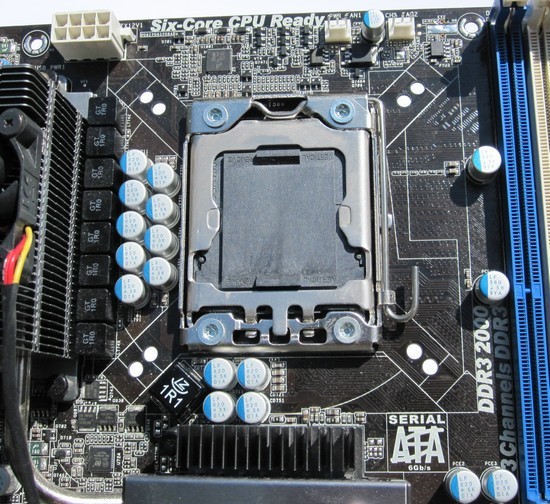
The socket area is relatively similar to other boards in the range - we had no such issues installing an Akasa Nero or a Corsair H50-1. However, the tall FET cooler will limit large coolers, such as the Prolimatech Armageddon, to one orientation only. The 'Combo Cooler Option' (ASRock marketing language for having holes for both 775 and 1366 coolers) is a nice addition to this area of the board, as mentioned previously.
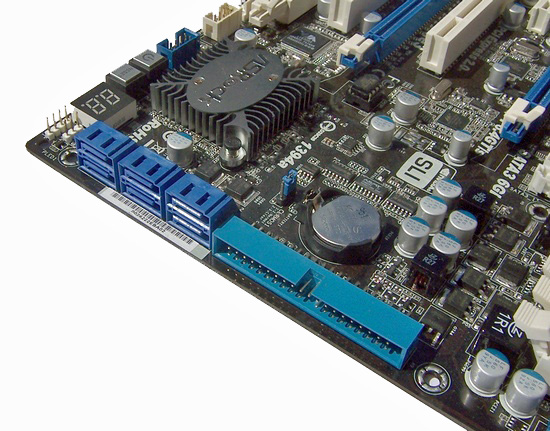
The SATA 3Gb/s ports are found at right angles to the board, so as not to disrupt any long PCIe cards used. Next to it is an IDE connector port, which despite hardware advances, is still in use today, even on enthusiast platforms. The same thing applies to the floppy port - a lot of industrial machinery still outputs data onto the floppy, so a workstation based on an enthusiast motherboard should be able to cope. However, the floppy drive connector is well out of the way, making it hard to reach should you need it. Where it would normally be, i.e. above the IDE port, is the system panel connectors and a USB header. It seems odd to put the system panel up in this area - most cases are designed to place the system panel in the bottom right hand side of the PCB.
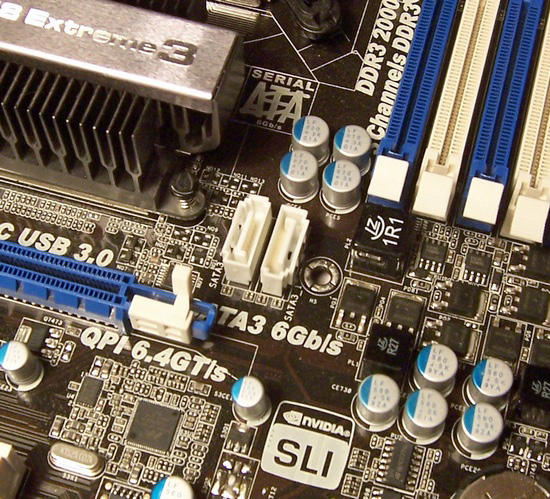
The SATA 6Gb/s ports are straight in the middle of the board. This is relatively absurd. As a result, SATA cables with either be stretching over RAM or graphics cards/power cables to get where they need to go - there is no cable management system in the word which will get around these issues.

Power and Reset buttons are starting to become a standard on boards designed for overclockable platforms, and the Extreme3 does not disappoint. Next to these two is a Debug LED, giving a two character hexadecimal code as the board boots up, and handy when dealing with support on a boot up issue.
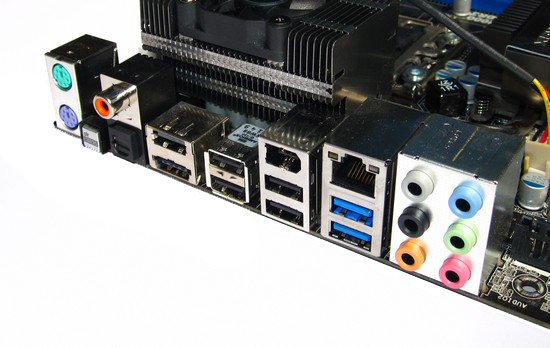
The back panel contains (from left to right) mouse and keyboard PS2 ports, a CLR CMOS button, coaxial and optical SPDIF, connections, a combined eSata 6Gb/s/USB2 port, five other USB2 ports, an IEEE 1394 FireWire port, two USB3 ports, a Realtek Gigabit LAN port, and the usual array of audio ports. While a board on an enthusiast socket may suggest dual LAN ports, given the budget end of the platform this board is aimed at, one LAN port seems fair. Despite the legacy nature of other parts of the board (such as the floppy and IDE connector), no serial or parallel ports are given on the Extreme3.


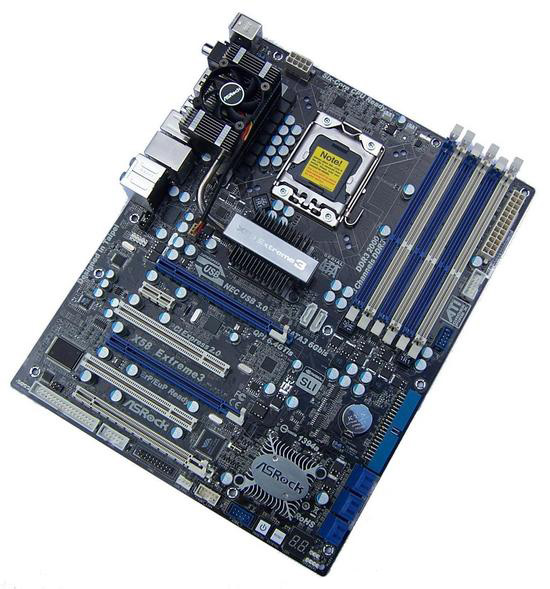








35 Comments
View All Comments
529th - Wednesday, June 2, 2010 - link
See, that's what I like about the Asrock Bios, very simple. The EVGA bios on the 760 classified needs to be modeled after a better bios.529th - Wednesday, June 2, 2010 - link
correction, BIOSRajinder Gill - Thursday, June 3, 2010 - link
Not sure that ASRock would be the brand for EVGA to follow. ASUS would make more sense.dingetje - Wednesday, June 2, 2010 - link
I would not call $190 a budget price. That's a FAIL title if I've ever seen one.jonup - Thursday, June 3, 2010 - link
There is only four cheaper ATX X58 MB on newegg.com. Except for the Foxconn one the others are priced between $170 and 190. The median price of X58 is arround $240 and the mean price is not much off that mark. Keep in mind that the ASrock comes with lots of bells and whistles.So for everyone complaining about the term budget in the title, it is a budget X58 board.Taft12 - Thursday, June 3, 2010 - link
As the poster above me has shown, the only FAIL here is your understanding of this market segment.dingetje - Friday, June 4, 2010 - link
oh, I understand it's as low as it goes for an X58 mobo.calling 190 bucks a budget price however is ridiculous imo.
jonup - Friday, June 4, 2010 - link
In absolute terms you are right. In relative terms it is a budget solution period. There are socket 1366 people with more expensive cooling solutions for 24/7 use than this MB. And I am not talking about the record setting freaks.LoneWolf15 - Thursday, June 3, 2010 - link
on the VRMs will get noisy and/or die within a year to a year and a half.Better to skip it as unnecessary and lower the price.
zero2dash - Thursday, June 3, 2010 - link
Why in the world would you mention the old X58-UD3R when the X58A-UD3R is available for $199-$219 depending on retailer, has USB3, SATA3, 6ram slots, a 4 PCIe slots?I bought 2 of them at Micro Center to replace the ASRock X58 Extreme that died on me after 2 months of use folding@home. First ASRock board, last ASRock board I will ever buy. One day it refused to power on for no reason. Once I got the RMA back, I sold it used because I didn't want to bother with ASRock anymore.
Now that Abit is out of the business, it's Gigabyte or nothing for me (Asus in a last ditch pinch if I had to have a board, otherwise GB beats Asus on bang for the buck). 2x X58A-UD3R and 1 EP45-UD3P all f@h 24/7, high oc's - no problems on any of them. Love GB.